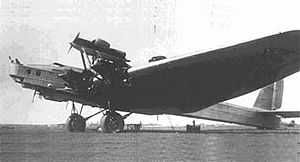Tupolev ANT-16
Tupolev ANT-16 (also known as TB-4; Russian: Тяжелый Бомбардировщик – Heavy Bomber) was an experimental heavy bomber aircraft designed and tested in the Soviet Union in the early 1930s. Conceptually representing evolution of the TB-3 bomber, ANT-16 was designed under the doctrine that size and payload were more important for a bomber than speed because it would be able to protect itself with defensive armament.[1] The twin 5×1.8×1.8 m (16 ft 5 in × 5 ft 11 in × 5 ft 11 in) bomb bays were the largest in the world at the time and presented many design challenges in order to preserve structural rigidity of the airframe.[1]
The sole prototype first flew on 3 July 1933 with M. M. Gromov at the controls. The test flight program was completed by 29 September 1933 with disappointing results. The two top-mounted engines performed poorly and a significant portion of thrust generated by the wing-mounted powerplants was absorbed by the 2-meter-thick (6 ft 7 in) wing. A proposal to re-equip the aircraft with Mikulin AM-35 engines of 933 kW (1,250 hp) was not implemented.[1]
Specifications (ANT-16)
Data from Shavrov 1985[1]
General characteristics
Performance
Armament
- Guns: 2x20mm cannon, 5x2 7.62mm DA machine guns
- Bombs: Up to 10,000 kg (22,046 lb) of bombs – 40 × 250 kg (551 lb) or 20 × 500 kg (1,102 lb)
See also
- Related development
References
- ↑ 1.0 1.1 1.2 1.3 Shavrov V.B. (1985). Istoriia konstruktskii samoletov v SSSR do 1938 g. (3 izd.) (in Russian). Mashinostroenie. ISBN 5-217-03112-3.
|
|---|
| | Civilian | |
|---|
| | Military | |
|---|
| | Unmanned | |
|---|
| | Experimental | |
|---|
| | Proposed | |
|---|
| | Historic | |
|---|
|
Soviet bomber designations |
|---|
| | BB (Blizhniy Bombardirovschik - "Short-Range Bomber") | |
|---|
| | DB (Dalniy Bombardirovschik - "Long-Range Bomber") | |
|---|
| | FB (Frontovoi Bombardirovschik - "Front-Line Bomber") | |
|---|
| | MTB (Morskoi Tyazholy Bombardirovschik - "Maritime Heavy Bomber") | |
|---|
| | SB (Skorostnoi Bombardirovschik - "Fast Bomber") | |
|---|
| | ShB (Shturmovoi Bombardirovschik - "Attack Bomber") | |
|---|
| | TB (Tyazholy Bombardirovschik - "Heavy Bomber") | |
|---|
|
|
|---|
| | General | |
|---|
| | Military | |
|---|
| | Accidents / incidents | |
|---|
| | Records | |
|---|
| | Misc. | |
|---|
|
